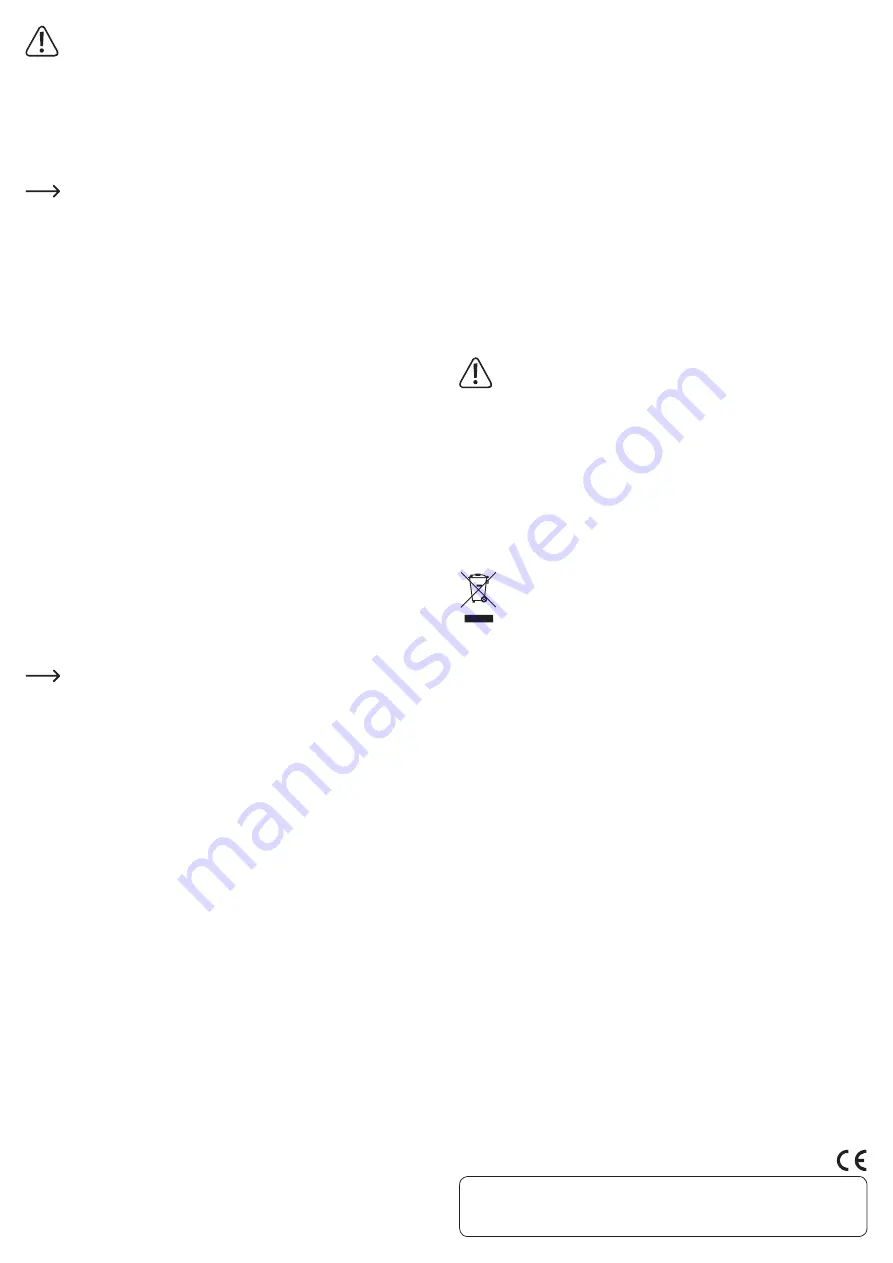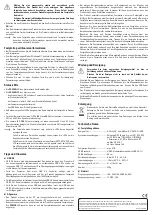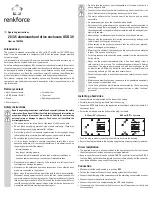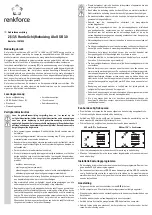
This is a publication by Conrad Electronic SE, Klaus-Conrad-Str. 1, D-92240 Hirschau (www.conrad.com).
All rights including translation reserved. Reproduction by any method, e.g. photocopy, microfilming, or the capture in electronic data
processing systems require the prior written approval by the editor. Reprinting, also in part, is prohibited. This publication represent the
technical status at the time of printing.
© Copyright 2014 by Conrad Electronic SE.
V1_0814_02-ETS-Mkd
Select a horizontal and stable surface of sufficient size for installation.
The product must not tip over. Any installed hard drive could be damaged.
That risk is even higher when the product is switched on and the hard
drive running.
Use suitable padding to protect valuable furniture from scratch or
pressure marks.
• Switch on the product. Set the on/off switch to position
ON
.
• The operating system will automatically recognize the product during first time
operation and complete the driver installation. The drivers are already included in
the operating system.
In order for the drive to be displayed in the device manager and to be ready
for use, partition and format the hard drive, if new (see next chapter).
Partitioning/formatting your hard drive
• For Windows® operating systems, you can use the control panel for partitioning
and formatting.
• When using Windows® 7, for example, open “System and security” from the control
panel. Click on “Management” and then on “Creating hard drive partitions”. Select
the respective hard drive and create a new partition.
• Then format the new partition. Quick formatting is sufficient in such a case.
Performing a normal formatting procedure can take a very long time to complete
depending on the hard drive capacity.
• Contact an expert if you have any doubts regarding partitioning/formatting.
Status LEDs
• The
POWER
LED lights up blue during operation.
• The
POWER
LED lights up red, when
- the product is connected to a PC via USB port but no hard drive is installed in the
product.
- the computer is in sleep or standby mode.
- the Computer is turned off.
- the USB cable is disconnected from the product.
• There are an additional five LEDs indicating the occupied space of the hard drive
memory.
• If, for example, the 2 lower LEDs
(20 %
and
40 %
) light up blue, then 20 % to 40 % of
the hard drive memory is occupied.
• The upper LED (
100 %
) lights up red steadily, when 80 % to 90 % of the memory is
occupied. When more than 90 % of the hard drive memory is occupied, the red LED
starts flashing.
The hard drive must have been formatted in order for the LEDs to indicate its
capacity.
If there is more than one partition on your hard drive, the LEDs will only
indicate the capacity of the first partition.
When using a hard drive of EXT3, EXT4, XFS or JFS formats under Linux
operating system, the LEDs might not indicate the capacity correctly under
some circumstances. In order to display the correct capacity, disconnect
the hard drive through the operating system and then connect it again.
Tips and notes
a) USB 3.0
• USB 3.0 devices are downwardly compatible. That means that the product with
the installed hard drive can also be connected to common USB 2.0 ports or slow
USB 1.1 ports. The transfer speed will be reduced accordingly, though.
• Ideally, USB 3.0 makes speeds of over 100 Mbyte/s possible depending on your
computer’s hard drive, the hard drive mounted in the casing, and the USB 3.0
controller.
• Using a common USB 2.0/1.1 cable instead of the included USB 3.0 cable will reduce
the transfer rate.
• If you want to connect the product via a USB hub, the USB hub has to support
USB 3.0 for the maximum transfer rate to be possible.
b) General
• The product can detect a PC being switched on/off and therefore turns itself on/off
accordingly. When turning the PC off or into standby mode, the hard drive integrated
in the product turns off. The
POWER
LED then lights up red and the hard drive
capacity is still indicated.
• Some operating systems, when in standby mode, only turn off the monitor and any
connected peripherals but continue to supply the mainboard with electricity. In
such a case the product might not switch to sleep mode.
• The product only supports hard drives with a sector size of 512 byte. When using a
hard drive with a sector size of 4 kB, the hard drive requires formatting before it can
be used. Please note that formatting will cause all data to be lost.
• Note that some operating systems do not support external hard drives with
capacities of >2 TB. Contact the manufacturer of the operating system for more
information.
• Please note that if disconnecting the connection cable during data transmission
files could be damaged or the operating system could shutdown. First safely remove
the hard drive through the operating system before disconnecting the connection
cable.
• Always handle hard drives very carefully. Impacts during operation and even for
several seconds after switching off the product can cause the reading/writing
heads to touch the magnetic discs, which in turn could damage the hard drive.
• When connecting the hard drive for the first time, it could take approx. one minute
for the hard drive to be recognized. The length of this time period varies depending
on the operating system.
Maintenance and cleaning
Do not use any aggressive cleaning agents as these may lead to
discoloration.
To prevent scratch marks, do not apply too much force on the surface
during cleaning.
• Switch off the product before cleaning. Disconnect the power adapter from the
mains. Wait for at least 30 seconds until all magnetic discs have come to a complete
stop. Disconnect the USB cable from the product.
• Besides occasional cleaning, the device is maintenance-free. To clean the device,
use a soft, anti-static and lint-free cloth.
• You can use a clean, long-haired brush and a vacuum cleaner to easily remove any
dust.
Disposal
Electronic devices are recyclable waste and must not be disposed of in the
household waste.
At the end of its service life, dispose of the product according to the
relevant statutory regulations.
You thus fulfil your statutory obligations and contribute to the protection of
the environment.
Technical data
a) Hard drive enclosure
Suitable for ...........................................6.35 cm/2.5“ or 8.89 cm/3.5“ SATA I/II HDD
System requirements ......................... Windows® XP (Home, Pro, with SP1, SP2, SP3,
only 32 bit), Vista™ (32/64 bit), 7 (32/64 bit),
7 Enterprise, 8, 8.1, 8 Pro, 8 Enterprise, RT
Mac OSX 10.7 and higher
Linux Ubuntu 10.4 and higher
Hard drive capacity ............................max. 4 TB
USB standard.......................................USB 3.0 (downward compatible to USB 2.0/1.1)
USB cable length ................................90 cm
Operating conditions ..........................0 to +45 ºC, 5 – 95 % RH
Storage conditions..............................-10 to +65 ºC, 5 – 95 % RH
Dimensions (W x H x D)......................31 x 115 x 191 mm
Weight ...................................................339 g
b) Power adapter
Input voltage/current..........................100 – 240 V/AC, 50/60 Hz, 0.4 A
Output voltage/current .......................12 V/DC, 1.5 A








